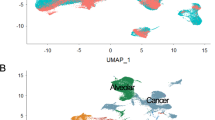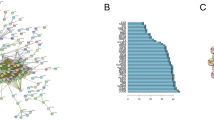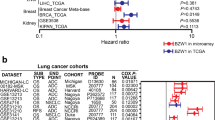Abstract
To explore the universal law of the abnormal gene expression and the structural variation of genes related to lung adenocarcinoma, the gene expression profile of GSE37765 were downloaded from Gene Expression Omnibus database. The differentially expressed genes (DEGs) were analyzed with t-test and NOISeq tool, and the core DEGs were screened out by combining with another RNA-seq data containing totally 77 pairs of samples in 77 patients with lung adenocarcinoma. Moreover, the functional annotation of the core DEGs was performed by using the Database for Annotation Visualization and Integrated Discovery following selection of oncogene and tumor suppressor by combining with tumor suppressor genes and Cancer Genes database, and motif-finding of core DEGs was performed with motif-finding algorithm Seqpos. We also used Tophat-fusion tool to further explore the fusion genes. In total, 850 downregulated DEGs and 206 upregulated DEGs were screened out in lung adenocarcinoma tissues. Next, we selected 543 core DEGs, including 401 downregulated and 142 upregulated genes, and vasculature development (P=1.89E−06) was significantly enriched among downregulated core genes, as well as mitosis (P=6.26E−04) enriched among upregulated core genes. On the basis of the cellular localization analysis of core genes, wnt-1-induced secreted protein 1 (WISP1) and receptor (G protein-coupled) activity modifying protein 1 (RAMP1) identified mainly located in extracellular region and extracellular space. We also screened one oncogene, v-myb avian myeloblastosis viral oncogene homolog-like 2 (MYBL2). Moreover, transcription factor GATA2 was mined by motif-finding analysis. Finally, four fusion genes belonged to the human leukocyte antigen (HLA) family. WISP1, RAMP1, MYBL2 and GATA2 could be potential targets of treatment for lung adenocarcinoma and the fusion of HLA family genes might have important roles in lung adenocarcinoma.
This is a preview of subscription content, access via your institution
Access options
Subscribe to this journal
Receive 12 print issues and online access
$259.00 per year
only $21.58 per issue
Buy this article
- Purchase on Springer Link
- Instant access to full article PDF
Prices may be subject to local taxes which are calculated during checkout


Similar content being viewed by others
References
Parkin DM, Bray F, Ferlay J, Pisani P . Estimating the world cancer burden: Globocan 2000. Int J Cancer 2001; 94: 153–156.
Parkin DM, Bray F, Ferlay J, Pisani P . Global cancer statistics, 2002. Cancer J Clin 2005; 55: 74–108.
Molina JR, Yang P, Cassivi SD, Schild SE, Adjei AA . Non-small cell lung cancer: epidemiology, risk factors, treatment, and survivorship. Mayo Clin Proc 2008; 83: 584–594.
Juergens RA, Brahmer JR . Adjuvant treatment in non-small cell lung cancer: where are we now? J Natl Compr Canc Netw 2006; 4: 595–600.
Schiller JH . Current standards of care in small-cell and non-small-cell lung cancer. Oncology 2001; 61 (Suppl 1): 3–13.
Ding L, Getz G, Wheeler DA, Mardis ER, McLellan MD, Cibulskis K et al. Somatic mutations affect key pathways in lung adenocarcinoma. Nature 2008; 455: 1069–1075.
Beer DG, Kardia SL, Huang C-C, Giordano TJ, Levin AM, Misek DE et al. Gene-expression profiles predict survival of patients with lung adenocarcinoma. Nat Med 2002; 8: 816–824.
Chen G, Gharib TG, Huang C-C, Thomas DG, Shedden KA, Taylor JM et al. Proteomic analysis of lung adenocarcinoma identification of a highly expressed set of proteins in tumors. Clin Cancer Res 2002; 8: 2298–2305.
Jiang H, Deng Y, Chen H-S, Tao L, Sha Q, Chen J et al. Joint analysis of two microarray gene-expression data sets to select lung adenocarcinoma marker genes. BMC Bioinformatics 2004; 5: 81.
Beane J, Vick J, Schembri F, Anderlind C, Gower A, Campbell J et al. Characterizing the impact of smoking and lung cancer on the airway transcriptome using RNA-Seq. Cancer Prev Res 2011; 4: 803–817.
Wang Z, Gerstein M, Snyder M . RNA-Seq: a revolutionary tool for transcriptomics. Nat Rev Genet 2009; 10: 57–63.
Tang F, Barbacioru C, Wang Y, Nordman E, Lee C, Xu N et al. mRNA-Seq whole-transcriptome analysis of a single cell. Nat Methods 2009; 6: 377–382.
Marioni JC, Mason CE, Mane SM, Stephens M, Gilad Y . RNA-seq: an assessment of technical reproducibility and comparison with gene expression arrays. Genome Res 2008; 18: 1509–1517.
Korbel JO, Urban AE, Affourtit JP, Godwin B, Grubert F, Simons JF et al. Paired-end mapping reveals extensive structural variation in the human genome. Science 2007; 318: 420–426.
Mikkelsen TS, Ku M, Jaffe DB, Issac B, Lieberman E, Giannoukos G et al. Genome-wide maps of chromatin state in pluripotent and lineage-committed cells. Nature 2007; 448: 553–560.
Cokus SJ, Feng S, Zhang X, Chen Z, Merriman B, Haudenschild CD et al. Shotgun bisulphite sequencing of the Arabidopsis genome reveals DNA methylation patterning. Nature 2008; 452: 215–219.
Kim SC, Jung Y, Park J, Cho S, Seo C, Kim J et al. A high-dimensional, deep-sequencing study of lung adenocarcinoma in female never-smokers. PLoS One 2013; 8: e55596.
Trapnell C, Pachter L, Salzberg SL . TopHat: discovering splice junctions with RNA-Seq. Bioinformatics 2009; 25: 1105–1111.
Trapnell C, Williams BA, Pertea G, Mortazavi A, Kwan G, van Baren MJ et al. Transcript assembly and quantification by RNA-Seq reveals unannotated transcripts and isoform switching during cell differentiation. Nat Biotechnol 2010; 28: 511–515.
Li C, Feng W, Qiu L, Xia C, Su X, Jin C et al. Characterization of skin ulceration syndrome associated microRNAs in sea cucumber Apostichopus japonicus by deep sequencing. Fish Shellfish Immunol 2012; 33: 436–441.
Tarazona S, García-Alcalde F, Dopazo J, Ferrer A, Conesa A . Differential expression in RNA-seq: a matter of depth. Genome Res 2011; 21: 2213–2223.
Seo J-S, Ju YS, Lee W-C, Shin J-Y, Lee JK, Bleazard T et al. The transcriptional landscape and mutational profile of lung adenocarcinoma. Genome Res 2012; 22: 2109–2119.
Dennis G Jr, Sherman BT, Hosack DA, Yang J, Gao W, Lane HC et al. DAVID: database for annotation, visualization, and integrated discovery. Genome Biol 2003; 4: P3.
Zhao M, Sun J, Zhao Z . TSGene: a web resource for tumor suppressor genes. Nucleic Acids Res 2013; 41: D970–D976.
Higgins ME, Claremont M, Major JE, Sander C, Lash AE . CancerGenes: a gene selection resource for cancer genome projects. Nucleic Acids Res 2007; 35 (suppl 1): D721–D726.
Liu T, Ortiz JA, Taing L, Meyer CA, Lee B, Zhang Y et al. Cistrome: an integrative platform for transcriptional regulation studies. Genome Biol 2011; 12: R83.
Kim D, Salzberg SL . TopHat-Fusion: an algorithm for discovery of novel fusion transcripts. Genome Biol 2011; 12: R72.
Cheung A, Deng W . Telomere dysfunction, genome instability and cancer. Front Biosci 2008; 13: 2075–2090.
Forbes SA, Bindal N, Bamford S, Cole C, Kok CY, Beare D et al. COSMIC: mining complete cancer genomes in the catalogue of somatic mutations in cancer. Nucleic Acids Res 2011; 39 (suppl 1): D945–D950.
Soon LL, Yie T-A, Shvarts A, Levine AJ, Su F, Tchou-Wong K-M . Overexpression of WISP-1 down-regulated motility and invasion of lung cancer cells through inhibition of Rac activation. J Biol Chem 2003; 278: 11465–11470.
Chen P-P, Li W-J, Wang Y, Zhao S, Li D-Y, Feng L-Y et al. Expression of Cyr61, CTGF, and WISP-1 correlates with clinical features of lung cancer. PLoS One 2007; 2: e534.
Margalit O, Eisenbach L, Amariglio N, Kaminski N, Harmelin A, Pfeffer R et al. Overexpression of a set of genes, including WISP-1, common to pulmonary metastases of both mouse D122 Lewis lung carcinoma and B16-F10. 9 melanoma cell lines. Br J Cancer 2003; 89: 314–319.
Zudaire E, Martınez A, Cuttitta F . Adrenomedullin and cancer. Regul Peptides 2003; 112: 175–183.
Logan M, Saab ST, Hameed O, Anderson PD, Abdulkadir SA . RAMP1 is a direct NKX3.1 target gene up-regulated in prostate cancer that promotes tumorigenesis. Am J Pathol 2013; 183: 951–963.
Tanner MM, Grenman S, Koul A, Johannsson O, Meltzer P, Pejovic T et al. Frequent amplification of chromosomal region 20q12-q13 in ovarian cancer. Clin Cancer Res 2000; 6: 1833–1839.
Miller LD, Smeds J, George J, Vega VB, Vergara L, Ploner A et al. An expression signature for p53 status in human breast cancer predicts mutation status, transcriptional effects, and patient survival. Proc Natl Acad Sci USA 2005; 102: 13550–13555.
Hosgood HD, Menashe I, Shen M, Yeager M, Yuenger J, Rajaraman P et al. Pathway-based evaluation of 380 candidate genes and lung cancer susceptibility suggests the importance of the cell cycle pathway. Carcinogenesis 2008; 29: 1938–1943.
Sarlomo-Rikala M, Andersson LC, Knuutila S, Miettinen M . DNA sequence copy number changes in gastrointestinal stromal tumors: tumor progression and prognostic significance. Cancer Res 2000; 60: 3899–3903.
Kumar MS, Hancock DC, Molina-Arcas M, Steckel M, East P, Diefenbacher M et al. The GATA2 transcriptional network is requisite for RAS oncogene-driven non-small cell lung cancer. Cell 2012; 149: 642–655.
Böhm M, Locke W, Sutherland R, Kench J, Henshall S . A role for GATA-2 in transition to an aggressive phenotype in prostate cancer through modulation of key androgen-regulated genes. Oncogene 2009; 28: 3847–3856.
Zheng R, Blobel GA . GATA transcription factors and cancer. Genes Cancer 2010; 1: 1178–1188.
Plowright L, Harrington K, Pandha H, Morgan R . HOX transcription factors are potential therapeutic targets in non-small-cell lung cancer (targeting HOX genes in lung cancer). Br J Cancer 2009; 100: 470–475.
Abe M, Hamada J-i, Takahashi O, Takahashi Y, Tada M, Miyamoto M et al. Disordered expression of HOX genes in human non-small cell lung cancer. Oncol Rep 2006; 15: 797–802.
Grier D, Thompson A, Kwasniewska A, McGonigle G, Halliday H, Lappin T . The pathophysiology of HOX genes and their role in cancer. J Pathol 2005; 205: 154–171.
Urosevic M, Kurrer MO, Kamarashev J, Mueller B, Weder W, Burg G et al. Human leukocyte antigen G up-regulation in lung cancer associates with high-grade histology, human leukocyte antigen class I loss and interleukin-10 production. Am J Pathol 2001; 159: 817–824.
Meissner M, Reichert TE, Kunkel M, Gooding W, Whiteside TL, Ferrone S et al. Defects in the human leukocyte antigen class I antigen processing machinery in head and neck squamous cell carcinoma: association with clinical outcome. Clin Cancer Res 2005; 11: 2552–2560.
Author information
Authors and Affiliations
Corresponding author
Ethics declarations
Competing interests
The authors declare no conflict of interest.
Rights and permissions
About this article
Cite this article
Yang, ZH., Zheng, R., Gao, Y. et al. Abnormal gene expression and gene fusion in lung adenocarcinoma with high-throughput RNA sequencing. Cancer Gene Ther 21, 74–82 (2014). https://doi.org/10.1038/cgt.2013.86
Received:
Revised:
Accepted:
Published:
Issue Date:
DOI: https://doi.org/10.1038/cgt.2013.86



